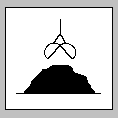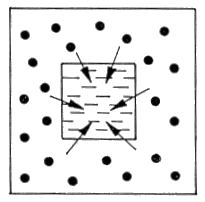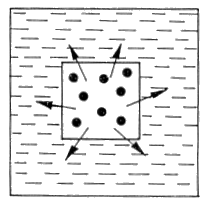| Salt | [German version] |
Table of contents |
|
| General: | ||
| Product information | ||
| Packaging | ||
| Transport | ||
| Container transport | ||
| Cargo securing | ||
Product information
Product name
| German | Salz, Speisesalz |
| English | Salt, common salt |
| French | Sel |
| Spanish | Sal |
| Scientific | Sodium chloride (NaCl) |
| CN/HS number * | 2501 00 ff. |
(* EU Combined Nomenclature/Harmonized System)
Product description
„Salt“ is the colloquial term for the chemical compound sodium chloride (NaCl). It is principally obtained by four processes:
| by mining of rock salt. In Germany, approx. 90% of all NaCl is obtained in this way. | |
| by the evaporation of natural or artificial saturated aqueous NaCl solutions. This may proceed with the aid of brines, which are obtained by pumping water into underground salt beds or from salt works („boiled salt“). | |
| by evaporation of saline seawater collected in large ponds or of water from salt lakes in hot countries (such as Spain or Southern France). This salt is also called sea salt. | |
| as a by-product of seawater desalination for obtaining drinking or process water. |
Salt has a solid, crystalline structure and is very hygroscopic. It attacks metals when combined with moisture.
Quality / Duration of storage
If allowed to absorb too much water vapor, salt begins to flow. If the water vapor is released again, lumps form.
Depending on its intended use (e.g. cooking salt), care should be taken to ensure that salt remains pourable and does not tend towards lump formation. This may be achieved by adding appropriate additives. Salt producers therefore use sodium ferrocyanide, which prevents salt crystals from agglomerating (sticking together).
If salt is stored in suitably dry and warm conditions, it may be stored for several years [1].
Intended use
Salt is used, among other things, as:
| cooking salt or table salt, as a seasoning for human consumption, | |
| curing salt, for salt meat and fish, | |
| cattle lick (dyed with iron oxide) in animal husbandry. | |
| industrial salt for freezing mixtures (denatured with kerosene or marked with dyes), | |
| salt grit for clearing roads in winter, | |
| pit salt for combatting coal dust in mining, | |
| hide salt for curing hides. |
Figures
(Click on the individual Figures to enlarge them.)
 Figure 1 |
 Figure 2 |
Countries of origin
Salt is produced extensively over all continents.
Back to beginning
Packaging
Salt is transported as bulk cargo as well as in barrels and bags (e.g. 3 – 5-ply paper bags with single plastic lining, 50 kg). The plastic lining prevents water vapor exchange between product and hold or container air.
Smaller amounts may also be packaged in cartons or cans ready for retail sale.
Back to beginning
Transport
Symbols
 General cargo |
 Bulk cargo |
Means of transport
Ship, truck, railroad
Container transport
Standard containers and bulk containers may be used, subject to compliance with lower limits for water content of goods, packaging and container flooring.
Cargo handling
In damp weather (rain, snow), the cargo must be protected from moisture.
No hooks of any kind may be used during handling of bagged goods, as they cause the salt to trickle out of the bags.
Stowage factor
| 1.25 m3/t (paper bags, 5-ply with plastic lining, 50 kg) [1] | |
| 1.47 m3/t (wooden barrels) [1] | |
| 1.06 – 1.11 m3/t (bags) [11] | |
| 0.98 – 1.11 m3/t (bulk) [11] |
Stowage space requirements
dry
Segregation
Bags: fiber rope, thin fiber nets, oiled paper, packing paper
Barrels: marker pen, oil crayon
Cargo securing
Because of their impact- and pressure-sensitivity, the packaging containers must be secured in such a way that damage is prevented. Bags must not develop tears and barrels must not break apart. Spaces between packages or pallets must be filled, to prevent slippage or tipping. Pallets must be loaded flush with their edges as protruding packages may readily result in damage.
Back to beginning
Risk factors and loss prevention
RF Temperature
Favorable travel temperature range: no lower limit – 25°C
If salt is transported into the subtropics and tropics, the temperature of the cargo of salt on unloading in the port of destination must be higher than the dew point temperature of the outside air, so as to prevent sweat from forming on the cargo.
If salt is loaded in Europe in the winter months, the consignor should ensure that the temperature of the salt is not below freezing point, as it is difficult to heat the product up during the voyage to tropical ports of destination. The most favorable cargo temperature is 15 – 20°C. Such salt (even in containers) may be stowed in the lower holds, as there is sufficient time for slow heating of the cargo given the relatively slight temperature difference between the port of loading and the port of discharge.
However, if the temperature of the salt at the port of loading is 0 – 10°C, it should preferably be stowed in holds above the water line, so as to achieve faster heating of the cargo.
Back to beginning
RF Humidity/Moisture
Salt requires particular humidity/moisture and possibly ventilation conditions (SC IV) (storage climate conditions).
| Designation | Humidity/water content | Source |
| Relative humidity | 55 – 65% | [1] |
| Water content | 0.05 – 0.5% | [1] |
| Maximum equilibrium moisture content | 65% | [1] |
At up to 74% relative humidity and 20°C, salt does not absorb any appreciable quantities of water vapor. The critical water content of sodium chloride (NaCl) is 0.5% at 74% relative humidity, which is the flow moisture point at which salt begins readily to absorb water vapor, and increases such that, at 75% relative humidity, the salt dissolves (hygroscopicity).
 Figure 3 |
If salt is loaded as bulk cargo, it is at risk from direct exposure to moisture, such as rain, snow or condensation water, during both cargo handling and transport.
The water vapor absorption of the salt is particularly critical when its temperature is below the dew point temperature of the hold or container air (see RF Temperature). In this case, the condensation zone spreads throughout the entire cargo and the salt becomes thoroughly wet. It is not possible to dry the wettened cargo of salt by ventilation, as it hardens and cakes when it releases water vapor due to recrystallization, so leaving monolithic surfaces. The utility value of the product is reduced considerably by the loss of flowability and the unloading process is rendered more difficult.
Hygroscopicity is increased by the addition of companion salts, such as KCl and MgCl2.
If the product is packaged in paper bags with plastic linings, a higher relative humidity than that indicated above is feasible. However, a higher relative humidity makes the paper packaging damp, so that it may be damaged during cargo handling.
Back to beginning
RF Ventilation
Salt requires particular humidity/moisture and possibly ventilation conditions (SC IV) (storage climate conditions).
As bagged salt is protected from water vapor exchange by a plastic lining, it does not normally need to be ventilated.
However, if it is transported as bulk cargo, note should be taken of the behavior of a cargo block in the event of temperature changes:
transport from temperate latitudes to the tropics = travel from cold to hot: the cargo block is heated from the outside, resulting in water vapor transport from the outside to the cold core, which causes caking of the outer layers while the inner layers display wetting phenomena (syrup formation). |
|
transport from the tropics to temperate latitudes = travel from hot to cold: if the cargo block cools down from the outside, resulting in water vapor transport from the warm core to the outside, wetness and mold may occur there while inside the release of water vapor by the warm core results in caking phenomena (loss of flowability). |
Back to beginning
RF Biotic activity
Salt displays zero order biotic activity.
Salt is a nonliving product and does not therefore display any biotic activity.
Back to beginning
RF Gases
Salt does not normally evolve any gases. However, contact with acids leads to the liberation of chlorine, which has an asphyxiating action and is toxic.
Back to beginning
RF Self-heating / Spontaneous combustion
No risk.
Back to beginning
RF Odor
| Active behavior | Salt does not release any odor. |
| Passive behavior | Salt is sensitive to unpleasant or pungent odors. It must not be loaded in holds or containers which were previously used to transport living animals or other odor-tainting goods. To prevent spoilage of salt, it must not be stored together with sugar, hides, tobacco, fish products and other goods with an intense odor. |
Back to beginning
RF Contamination
| Active behavior | Salt creates dust. Goods at risk of rusting, such as iron, sheet metal, wire coils, engines, machinery or motor vehicles, may be rapidly corroded by salt dust in conjunction with moisture. |
| Passive behavior | Salt is sensitive to dust, dirt, fats and oils. The holds or containers must accordingly be clean and in a thoroughly hygienic condition before loading. If the product is transported in linen cloth bags, anyone entering the holds or containers must do so only in soft, clean footwear, as salt is very sensitive to contamination. Salt solutions and salt dust have a highly corrosive action on metals. |
Back to beginning
RF Mechanical influences
Because of the impact- and pressure-sensitivity of the bags and barrels, they must be handled with appropriate care during cargo handling, transport and storage. No hooks of any kind may be used during handling of bagged goods, as they cause the salt to trickle out of the bags. Where plastic packaging is damaged, humidity and temperature fluctuations may lead to agglomeration, so rendering the surface monolithic (particularly in the case of fine-grained salt).
Back to beginning
RF Toxicity / Hazards to health
There is normally no risk. Storage together with acids results in the formation of chlorine, which is asphyxiating and toxic.
Back to beginning
RF Shrinkage/Shortage
Weight losses of approx. 5% due to water vapor release are deemed normal. To these must be added trickle losses, which arise during cargo handling.
Back to beginning
RF Insect infestation / Diseases
Salt is not subject to insect infestation.
Back to beginning
